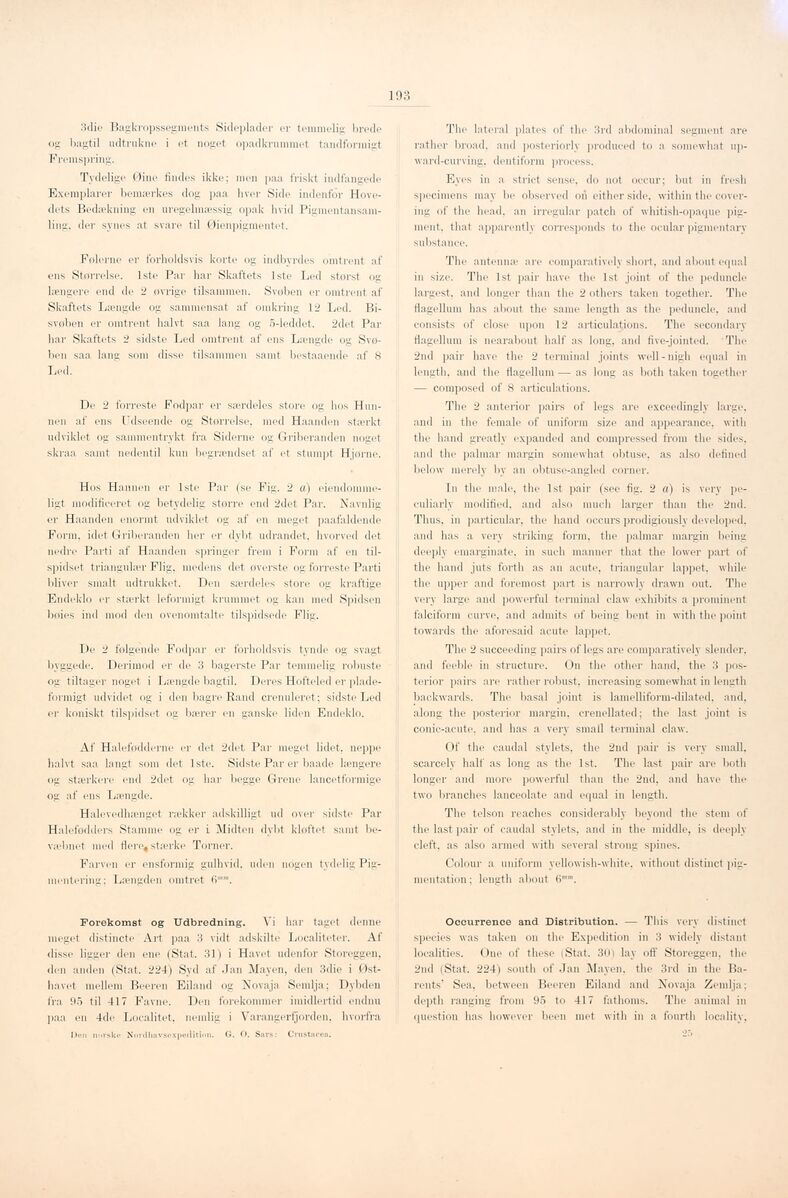
Full resolution (JPEG) - On this page / på denna sida - Sidor ...

<< prev. page << föreg. sida << >> nästa sida >> next page >>
Below is the raw OCR text
from the above scanned image.
Do you see an error? Proofread the page now!
Här nedan syns maskintolkade texten från faksimilbilden ovan.
Ser du något fel? Korrekturläs sidan nu!
This page has never been proofread. / Denna sida har aldrig korrekturlästs.
3die Bagkropssegments Sideplader er temmelig lirede
og bagtil udtrukne i et noget opadkrummet tandformigt
Fremspring.
Tydelige Øine findes ikke; men paa friskt indfangede
Exemplarer bemærkes dog paa hver Side indenfor
Hovedets Bedækning en uregelmæssig opak hvid
Pigmentansamling. der synes at svare til Øienpigmentet.
Folerne er forholdsvis korte og indbyrdes omtrent af
ens Størrelse, lste Par har Skaftets lste Led storst og
længere end de 2 øvrige tilsammen. Svøben er omtrent af
Skaftets Længde og sammensat af omkring 12 Led.
Bi-svøben er omtrent halvt saa lang og 5-leddet. 2det Par
har Skaftets 2 sidste Led omtrent af ens Længde og
Svøben saa lang som disse tilsammen samt bestaaende af 8
Led.
De 2 forreste Fodpar er særdeles store og hos
Hunnen af ens Udseende og Størrelse, med Haanden stærkt
udviklet og sammentrykt fra Siderne og Griberanden noget
skraa samt nedentil kun begrændset af et stumpt Hjørne.
Hos Hannen er lste Par (se Fig. 2 a)
eiendommeligt modificeret og betydelig større end 2det Par. Navnlig
er Haanden enormt udviklet og af en meget paafaldende
Form, idet Griberanden her er dybt udrandet, hvorved det
nedre Parti af Haanden springer frem i Fonn af en
tilspidset triangulær Flig, medens det øverste og forreste Parti
bliver smalt udtrukket. Den særdeles store og kraftige
Endeklo er stærkt leformigt krummet og kan med Spidsen
boies ind mod den ovenomtalte tilspidsede Flig.
De 2 følgende Fodpar er forholdsvis tynde og svagt
byggede. Derimod er de 3 bagerste Par temmelig robuste
og tiltager noget i Længde bagtil. Deres Hofteled er
pladeformigt udvidet og i den bagre Rand crenuleret; sidste Led
er koniskt tilspidset og bærer en ganske liden Endeklo.
Af Halefødderne er det 2det Par meget lidet, neppe
halvt saa langt som ilet lste. Sidste Par er baade længere
og stærkere end 2det og har begge Grene lancetformige
og af ens Længde.
Halevedhænget rækker adskilligt ud over sidste Par
Halefødders Stamme og er i Midten dybt kløftet samt
bevæbnet med flere, stærke Torner.
Farven er ensformig gulhvid. uden nogen tydelig
Pigmentering; Længden onitret 6"1"’.
209
The lateral plates of the 3rd abdominal segment are
rather broad, and posteriorly produced to a somewhat
upward-curving, dentiform process.
Eyes in a strict sense, do not occur; but in fresh
specimens may lie observed oii either side, within the
covering of the head, an irregular patch of whitish-opaque
pigment, that apparently corresponds to the ocular pigmentary
substance.
The antennæ are comparatively short, and about equal
in size. The 1st pair have the 1st joint of the peduncle
largest, and longer than the 2 others taken together. The
flagellum lias about the same length as the peduncle, and
consists of close upon 12 articulations. The secondary
flagellum is nearabout half as long, and five-jointed. The
2nd pair have the 2 terminal joints well-nigh equal in
length, and the flagellum — as long as both taken together
— composed of 8 articulations.
The 2 anterior pairs of legs are exceedingly large,
and in the female of uniform size and appearance, with
the hand greatly expanded and compressed from the sides,
and the palmar margin somewhat obtuse, as also defined
below merely by an obtuse-angled corner.
In the male, the 1st pair (see fig. 2 a) is very
peculiarly modified, and also much larger than the 2nd.
Thus, in particular, the hand occurs prodigiously developed,
and has a very striking form, the palmar margin being
deeply emarginate, in such manner that the lower part of
the hand juts forth as an acute, triangular lappet, while
the upper and foremost part is narrowly drawn out. The
very large and powerful terminal claw exhibits a prominent
falciform curve, and admits of being bent in with the point
towards the aforesaid acute lappet.
The 2 succeeding pairs of legs are comparatively slender,
and feeble in structure. On the other hand, the 3
posterior pairs are rather robust, increasing somewhat in length
backwards. The basal joint is lamelliform-dilated, and,
along the posterior margin, crenellated; the last joint is
conic-acute, and has a very small terminal claw.
Of the caudal stylets, the 2nd pair is very small,
scarcely half as long as the 1st. The last pair are both
longer and more powerful than the 2nd, and have the
two branches lanceolate and equal in length.
The telson reaches considerably beyond the stem of
the last pair of caudal stylets, and in the middle, is deeply
cleft, as also armed with several strong spines.
Colour a uniform yellowish-white, without distinct
pigmentation; length about 6"".
Forekomst og Udbredning. Yi har taget denne
meget distincte Art paa 3 vidt adskilte Localiteter. Af
disse ligger den ene (Ståt. 31) i Havet udenfor Storeggen,
dell anden (Ståt. 224) Syd af Jan Mayen, dell 3die i
Øst-havet mellem Beeren Eiland og Novaja Semlja; Dybden
fra 95 til 417 Favne. Dell forekommer imidlertid endnu
paa en 4de Localitet, nemlig i Yarangerfjorden, hvorfra
»en norske Nordliavsexpeditinn. G. O. Sars: Crustacea.
Occurrence and Distribution. — Tilis very distinct
species was taken on the Expedition in 3 widely distant
localities. One of these (Ståt. 30) lay off Storeggen, the
2nd (Ståt. 224) south of Jan Mayen, the 3rd in the
Barents’ Sea, between Beeren Eiland and Novaja Zemlja;
depth ranging from 95 to 417 fathoms. The animal in
question has however been met with in a fourth locality,
<< prev. page << föreg. sida << >> nästa sida >> next page >>